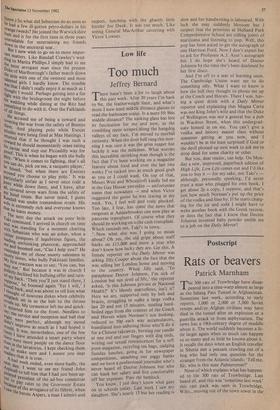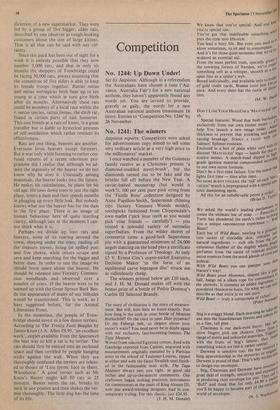Postscript
Rats or beavers
Patrick Marnham
The 300 rats of Trowbridge have disap- peared into a time-warp almost as large as the Salang Pass Tunnel in Afghanistan. Sometime last week, according to early reports, 1,000 or 2,000 or 5,000 Soviet troops and/or Afghan civilians may have died in the tunnel after an explosion or a guerrilla attack or from asphyxiation. The news has a 19th-century degree of muddle about it. The world suddenly becomes a lit- tle larger again when so much can happen to so many and so little be known about it. It recalls the days when an English traveller in Siberia met a peasant crawling out of a bog who had only one question for the stranger from the Atlantic islands: 'Tell me, Sir, who is this man Pahnerstron?'
None of which explains what has happen- ed to the 300 rats of Trowbridge. Last heard of, and this was 'sometime last week' this vast pack was seen in Trowbridge, Wilts., moving out of the town sewer in the direction of a new supermarket. They were led by a group of five bigger, older rats, described by one observer as tough-looking customers about the size of large kittens. That is all that can be said with any cer- tainty.
Since this pack has been out of sight for a week it is entirely possible that they now number 3,000 rats, and that in only six months the shoppers of Trowbridge could be facing 30,000 rats, always assuming that the committee of five elders is able to keep its female troops together. Balms rattus and rattus norvegicus both bear up to ten young at a time which in turn give birth after six months. Alternatively these rats could be members of a local race within the r. rattus species, rattusfossus, the ditch rat, found in certain parts of east Somerset. This one breeds at a rate of knots, is a great traveller but is liable to hysterical gestures of self-mutilation which rather restricts its effectiveness.
Rats are one thing, beavers are another. Everyone loves beavers except foresters. But it was only while listening to rather con- fused reports of a recent television pro- gramme did I realise that although we ad- mire the ingenuity of the beaver we do not know why he does it. Unusually among mammals, the beaver looks into the future. He makes his calculations, he plans for his old age. He saws down trees in just the right place, erects a dam and then spends months in plugging up every little leak. But nobody knows what use the beaver has for the dam in the first place. There is an image of human behaviour here of quite startling clarity, although just at the moment I can- not think what it is.
Perhaps we divide up into rats and beavers, some of us roaring around the town, sleeping under the stars, raiding all the treasure troves, living on spilled port and free cheese, while others scrape and save and keep searching for the bigger and better dam. In order to test the image we should learn more about the beaver. He should be released into Forestry Commis- sion woodlands and observed over a number of years. If the beaver were to be teamed up with the Great Spruce Bark Bee- tle the appearance of many of our hillsides would be transformed. This is work, as I have suggested before, for the Animal Liberation Front.
In the meantime, the people of Trow- bridge should invest in a few dozen terriers. According to The Trinity Foot Beagles by James Knox (J.A. Allen £9.95, 'an excellent work', copies available from the Spectator) the best way to kill a rat is by terrier. The rats should first be enticed into an enclosed space and then terrified by people banging sticks against the wall. When they are thoroughly confused the terriers are releas- ed to shouts of 'Lieu (pron. loo) in there. Whoohoop.' A good terrier such as Mr Knox's Buster might kill 50 rats in 25 minutes. Buster seizes the rat, breaks its neck in one pounce and then shakes the ver- min thoroughly. The little dog has the time of its life.















































 Previous page
Previous page